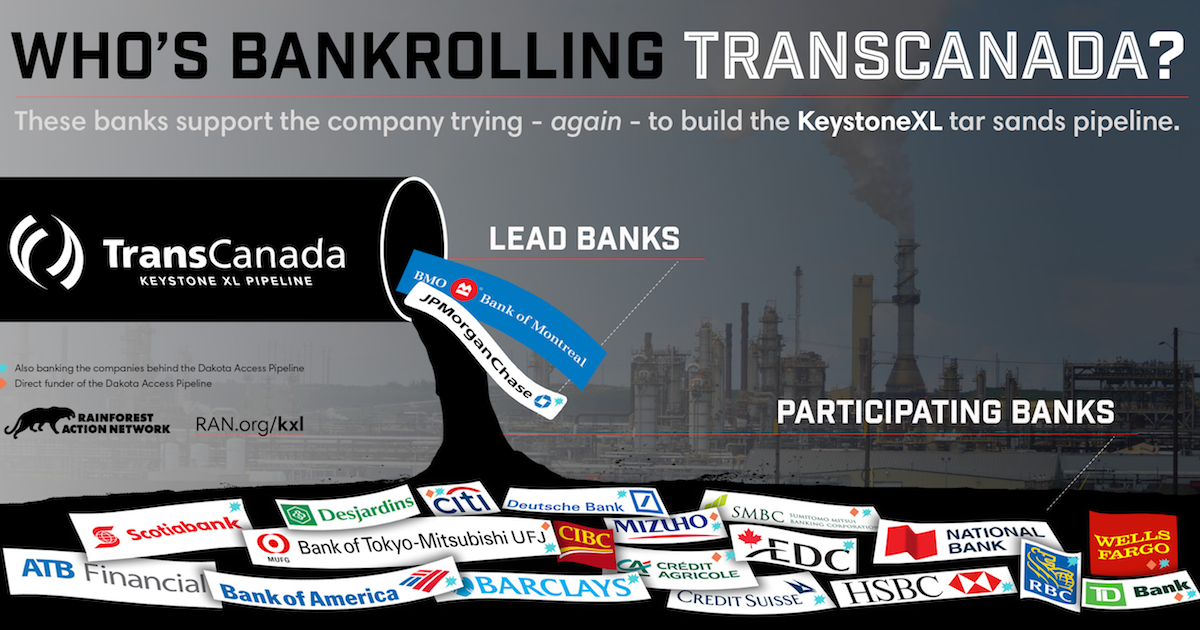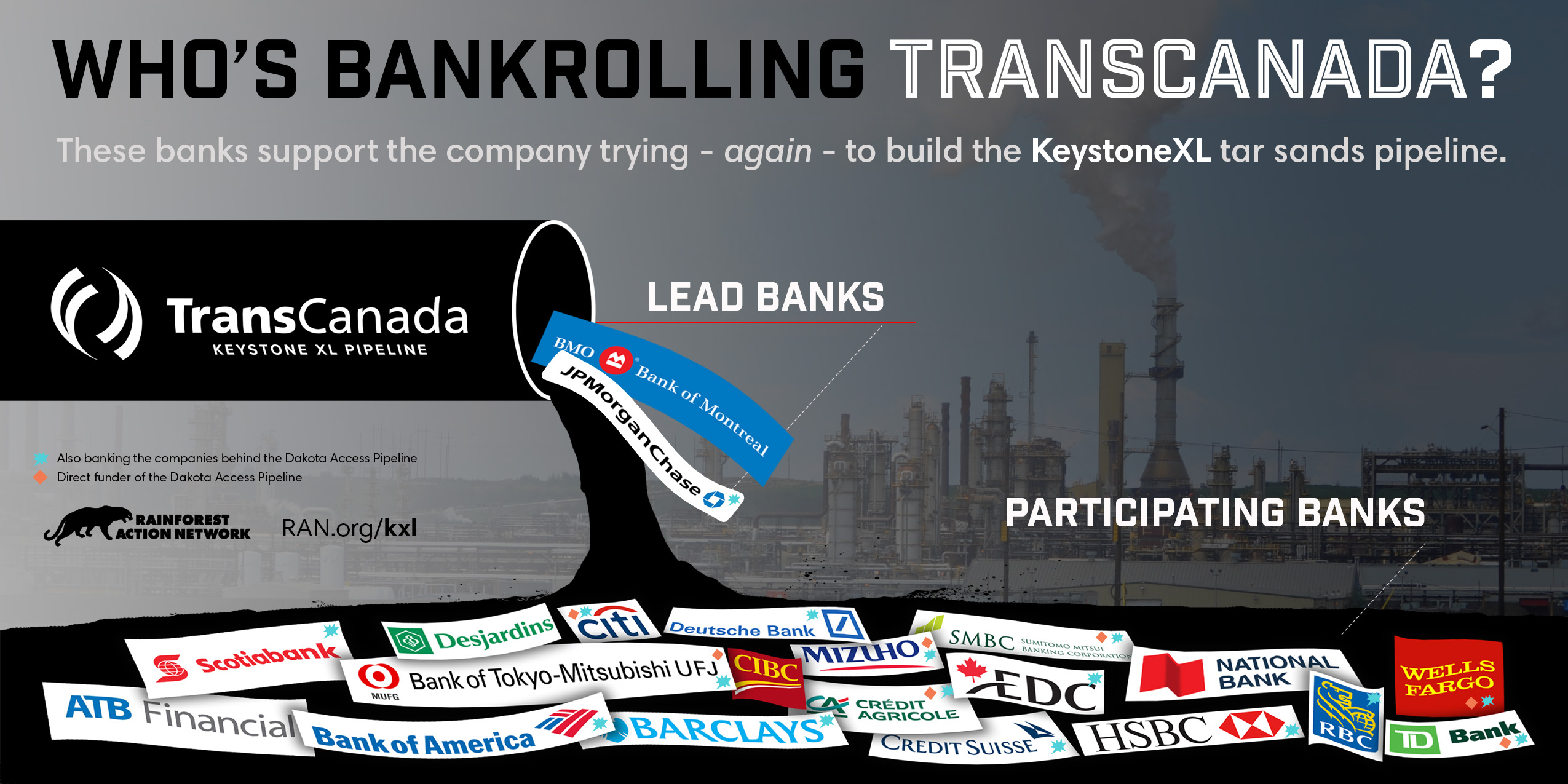Read part 2 of this 2-part blog here.
Credit Facilities Up for Renewal
The Keystone XL tar sands pipeline: It’s an environmental disaster, it’s a human rights disaster, and it’s an economic nightmare — yet TransCanada seems willing to risk everything to keep it alive.
The latest twist in this story came this past November. TransCanada, the company behind Keystone XL (KXL), received a lukewarm go-ahead from the state of Nebraska. Their application to build this pipeline from Alberta to Texas — and straight through private and public land in Nebraska — was not flatly denied. However, the company was denied approval for their preferred route.
These massive pipelines require two things to go forward: permits and money. And this permitting set-back in Nebraska may also impact the finances for the project.
The critical piece of the puzzle to be solved is how exactly TransCanada will pay for the KXL pipeline. The current projected cost? USD $8 billion.
TransCanada currently has two revolving credit facilities totaling $1.5 billion that are set to expire on December 15, 2017. As we’ve explained previously (Who’s Banking TransCanada) these lines of credit act as giant credit cards for the company and they are provided by major banks such as JPMorgan Chase — the top Wall Street funder of tar sands.
Here are some more details: one of these financial tools is a $1 billion revolving credit facility for TransCanada Pipeline USA Ltd. The other is a $500 million credit facility for TransCanada American Investment Ltd. Both were last extended one year ago, on December 16, 2016. A “business-as-usual” scenario for tomorrow could be that the banks providing this credit simply rubber stamp their renewal, giving the company more time to borrow from these funds for its general operating purposes — including for projects like the Keystone XL pipeline.
But things have changed recently. Since the Nebraska decision that denied TransCanada its preferred route, over 44,000 people have signed a petition to lead bank JPMorgan Chase, demanding the bank step away from this credit renewal. Over 1,000 people have called JPMorgan Chase’s head business office. And a small group of water protectors made their way to The Plaza Hotel at the Wells Fargo Thought Leadership Forum and attempted to deliver the petitions to Jamie Dimon, JPMorgan Chase’s CEO. These peaceful activists were forcibly removed — but their message was heard loud and clear.
TransCanada’s Final Investment Decision Coming this Month?
A final investment decision (FID) is a company’s decision on whether or not to move forward with a project. It reflects the company’s thinking about how the project fits into the company’s overall assets and capital structure. FIDs can include conditionals — for instance, where the company states it intends to proceed with the project as long as it ends up being granted a particular permit.
After Donald Trump gave TransCanada the federal green light for KXL in March 2017, the company gave an indication of timing for its FID on July 28, 2017, when discussing second quarter earnings. TransCanada stated that it was planning to make an FID in November or December 2017, after taking into account shipper demand and the Nebraska decision.
In early November, when discussing third quarter earnings, TransCanada CEO again said that the FID would come after the Nebraska Public Service Commission (PSC) decision. On November 28, after the Nebraska PSC decision, the CEO said the company is looking to make a final investment decision as soon as possible.
An affirmative FID from TransCanada may be a general statement on the company’s decision to move forward with the project. For context, here is an example of a conditionally positive FID from TransCanada from June 2015. It does not include details on how the project will be financed, but rather states that the company will move forward when a few key conditions are met. In contrast, here is the FID from Kinder Morgan’s Trans Mountain from May 2017, which includes details on how the pipeline would be financed.
What’s it all mean?
It is still unclear to what extent these credit renewals and the FID on the project at large will be related. If TransCanada were planning to use a large part of the proceeds for KXL and it turns out construction will be further delayed, they may not require the full dollar amount of these lines of credit. That said, if these facilities are easy for them to get renewed and signal to investors that banks remain confident in TransCanada, they may renew them at the current level.
TransCanada has indicated that its credit facilities are part of the mix that the company could use to fund its projects. That said, as of September 30, 2017 TransCanada’s liabilities exceed its assets by $5.4 billion — whereas at the end of 2016 they were nearly even. The company may need to prove to investors it can rebalance by using its credit facilities or a new bond or share issuance to pay down debt.
RAN and our network of allies will be keeping a close eye on how big banks respond to this climate test: Will Wall Street continue to bank the company behind this disastrous pipeline, or will they step away from these projects?

